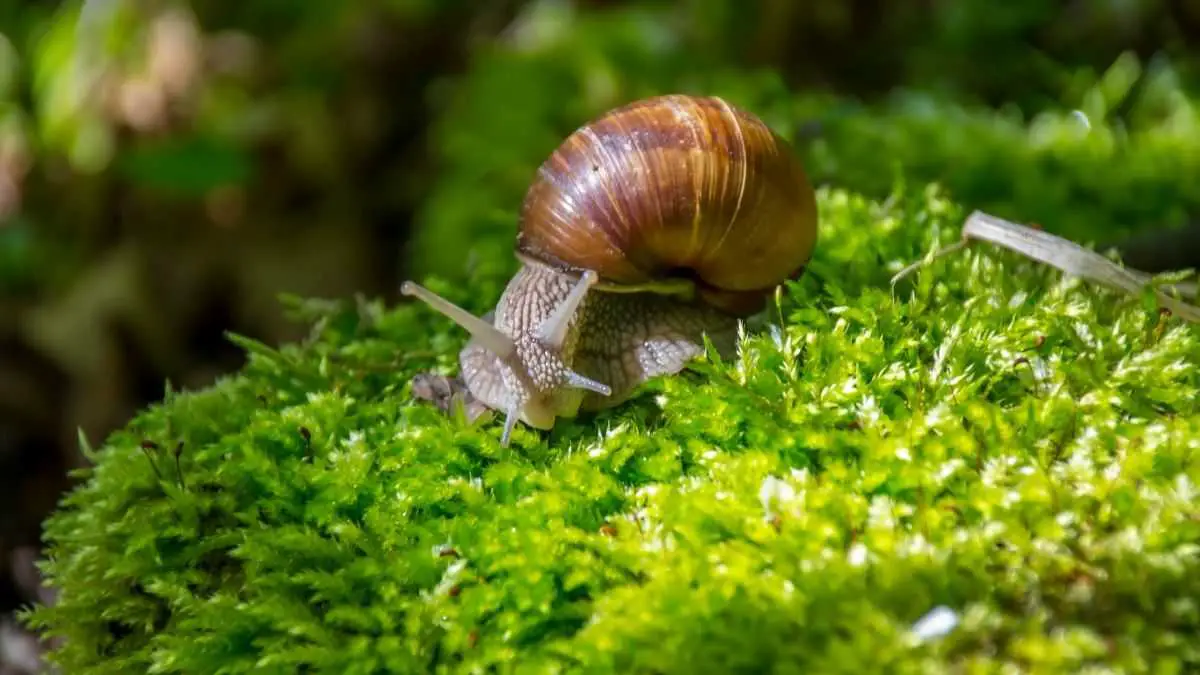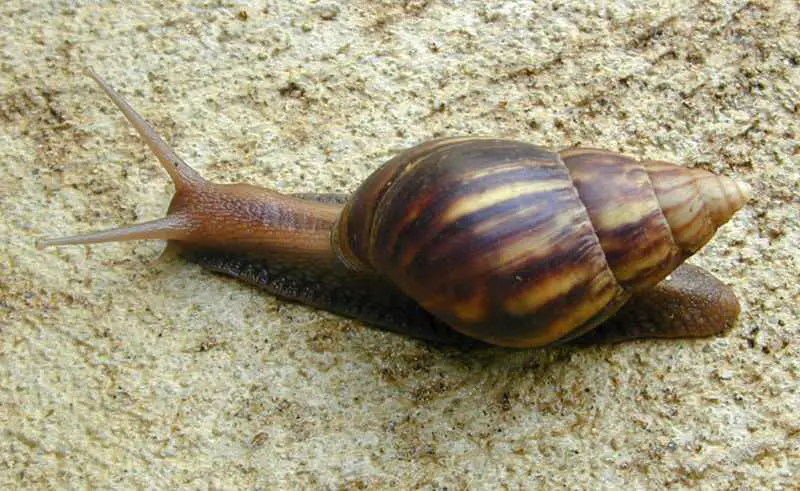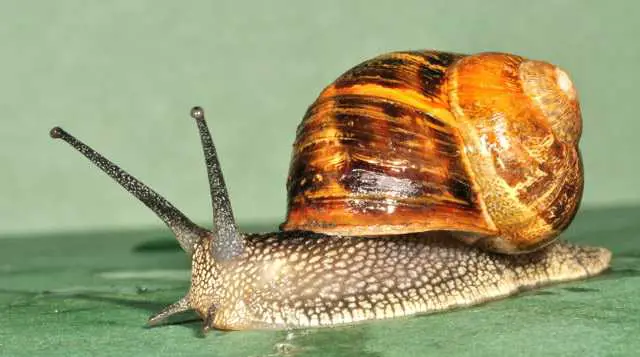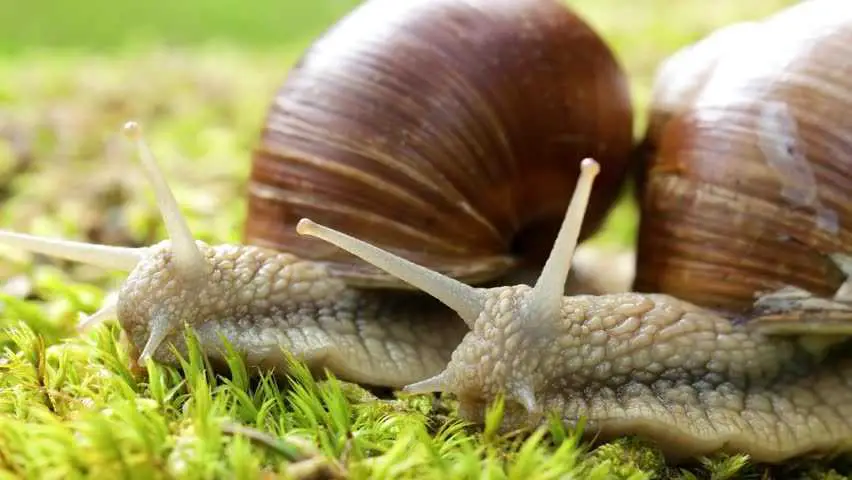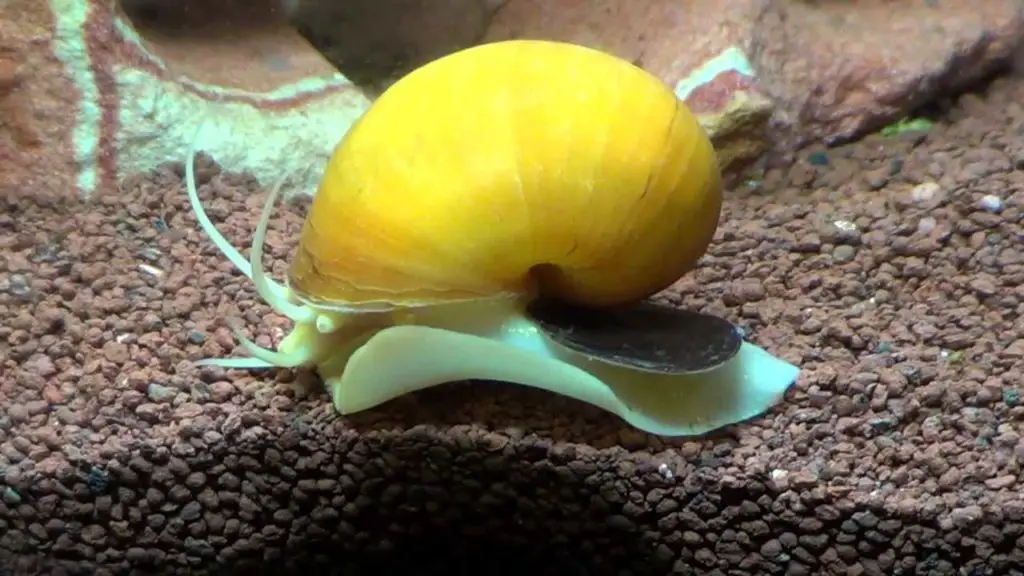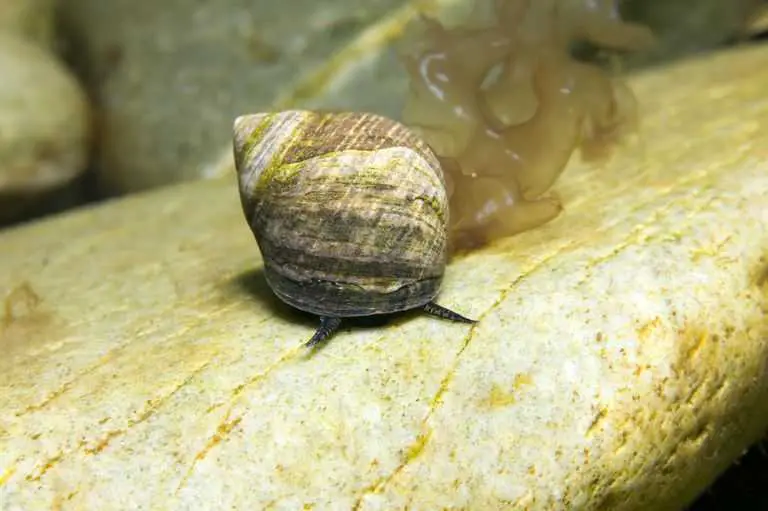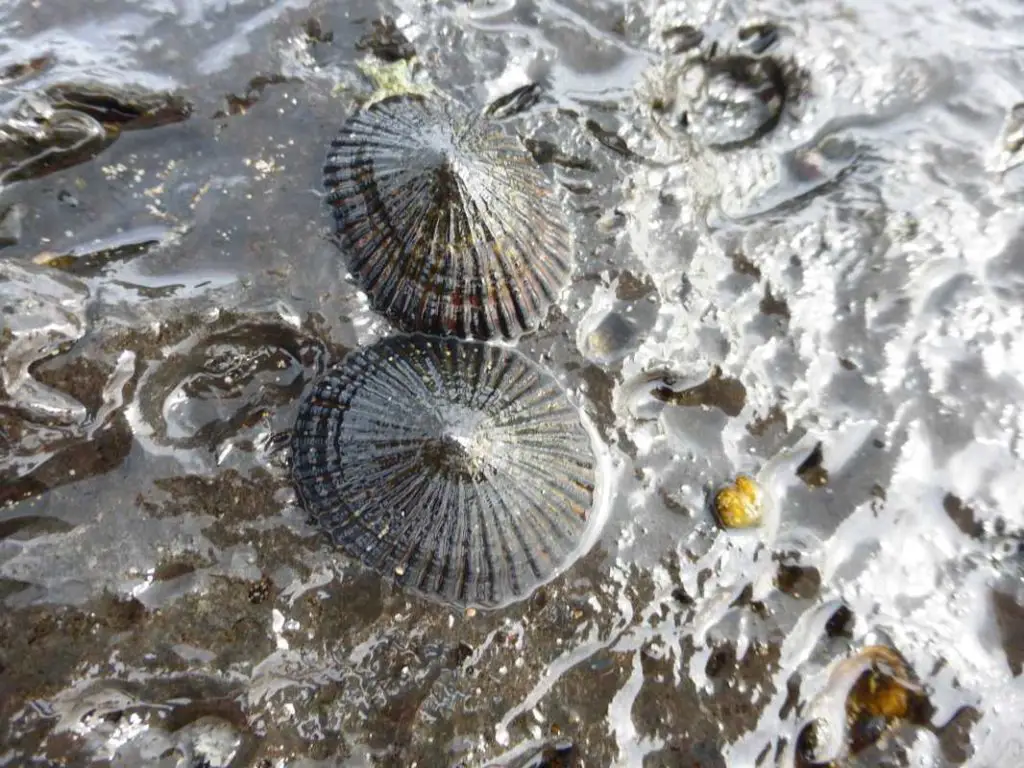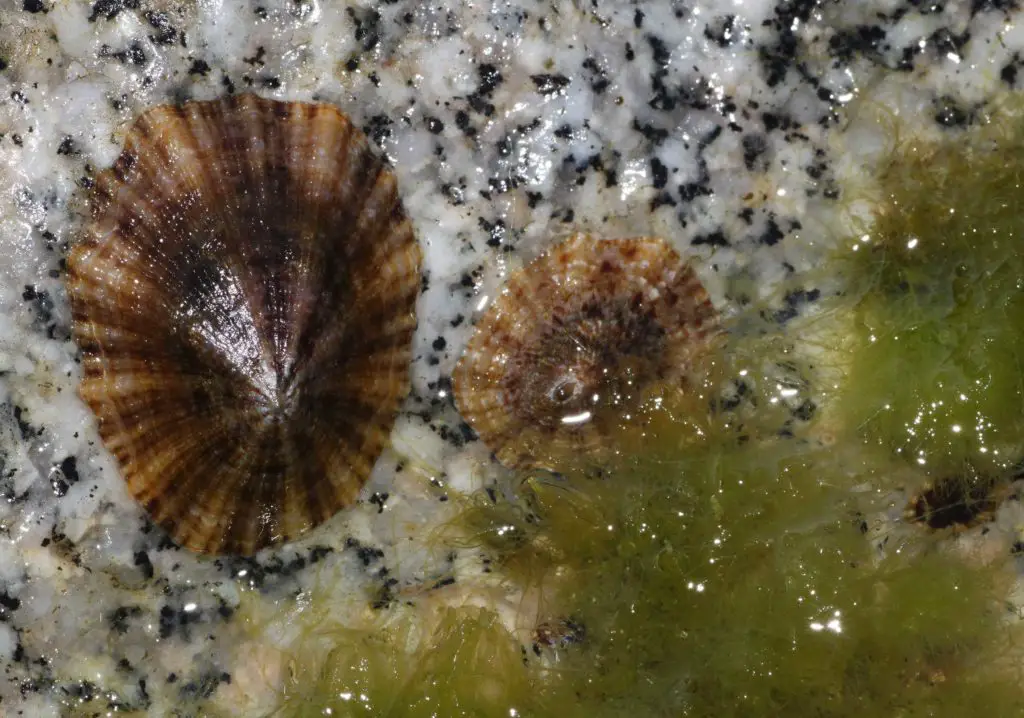The name snail is most often applied to land snails, however, there are many different types of snails. In fact, there are over 4000 snail species that also includes different kinds of sea snails and freshwater snails.
Did you know that snails are gastropod mollusks that have shells and those without shells are known as slugs? Yes, a slug is a snail! Well, at least, they belong to the same class of animals. Mind-blowing!
Contents
Types of Land Snail
Let’s start by exploring some of the land snail types. However, you should know that some snails are amphibious types of animals. This means that that they can live on land and in water. These ones just prefer land more.
Giant African Land Snail
The giant African snail is an 8-inch long snail that’s originally native to Africa. However, they can now be found on every continent except for Antarctica. They are one of the largest snail species.
The giant African snail has a high reproduction rate and has an insatiable craving for crops and vegetation in general. These two things make them an invasive species of snail. Despite this fact, some people think that they make good pet snails.
They have light to dark brown colored shells and some have vertical stripes on their shells that are usually a darker shade of brown. On average, a giant African land snail can live for 5 to 7 years. However, there’s evidence to suggest that they can live up to 10 years as well.
- Scientific name: Achatina fulica
- Kingdom: Animalia
- Family: Achatinidae
- Class: Gastropoda
- Phylum: Mollusca
Garden Snail
Garden snails are a small species that grows to a length of up to 1.3 inches. These types of snails have a particular shell pattern that differentiates it from other species.
A garden snail’s shell is yellowish or cream-colored with brown spiral stripes. They are native to the Mediterranean region, Western Europe, part of Asia, and northern Egypt. It feeds on various types of fruit trees, vegetable crops, rose bushes, garden flowers, and cereals.
- Scientific name: Cornu aspersum (formerly Helix aspersa)
- Speed: 0.029 mph (Maximum, Adult)
- Class: Gastropoda
- Phylum: Mollusca
- Family: Helicidae
Roman Snail
Two third’s of a Roman snail’s weight is thanks to its beautiful shell. These species of snail were once only native to Europe. However, they can be found in most parts of the world nowadays. It prefers to live in temperate forests where the temperature is humid with little rainfall. It has a creamy to light brown shell with darker brown bands. The Roman snail also goes by the names burgundy snail or ‘edible snail’. It’s the snail the French use to make escargot!
- Class: Gastropoda
- Scientific name: Helix pomatia
- Phylum: Mollusca
- Family: Helicidae
- Order: Stylommatophora
- Kingdom: Animalia
Mediterranean Green Snail
These types of land snails are sometimes simply called green snails or green garden snails. They are native to Europe (near the Mediterranean sea) and Africa and live in rainforests. It can grow up to 5 inches in length. These snails feed on a wide range of plants like most leafy vegetables, cereal crops, pasture grasses, and native plants.
In the 1980s, the Mediterranean green snail was found infesting over 350 hectares of market gardens, suburban gardens and neighboring bush areas near Perth, Australia.
- Scientific name: Cantareus apertus or Helix aperta
- Kingdom: Animalia
- Phylum: Mollusca
- Class: Gastropoda
- Sub-order: Pulmonata
- Family: Helicidae
- Genus: Cantareus
- Species: apertus
White Garden Snail
The white garden snail, sand hill snail, white Italian snail, Mediterranean coastal snail, or simply just the Mediterranean snail, is an edible species of medium-sized, air-breathing land snail.
- Scientific name: Theba pisana
- Phylum: Mollusca
- Higher classification: Theba
- Rank: Species
- Family: Helicidae
- Kingdom: Animalia
White-lipped Snail
The white-lipped snail or garden banded snail is a medium-sized species of air-breathing land snail. It has a glossy, smooth shell, which is typically yellow in color but may be pink, brown or red.
There are up to 5 variable spiral dark bands and nearly always has an obvious white lip around the shell opening.
Milk Snail
Otala lactea, known as the milk snail or Spanish snail, is a large, edible species of air-breathing land snail. Its shell is whitish or brownish and has darker speckled stripes. It typically feeds on papaya, lily, anise, broccoli, cabbage, cauliflower, celery, lettuce, and yucca plants. This edible snail is often consumed in the Mediterranean region.
Types of Freshwater Snails
Freshwater snails are a popular type of pet snails that you can shop for on online fish stores for your aquarium. Here are the different types of freshwater snails.
Apple Snails
Apple snail is a general name for freshwater snails that you’d find in pet stores for freshwater aquariums. For example, the mystery snail (Pomacea bridgesii) is a species of Apple Snail. They come in many different colors including gold, tiger-striped, blue, or white. And, some have been known to grow up to 6 inches in length. I personally keep a few with my guppies.
Ampullariidae, common name the apple snails, is a family of large freshwater snails, aquatic gastropod mollusks with a gill and an operculum.
https://en.wikipedia.org/wiki/Ampullariidae
- Scientific name: Ampullariidae
- Clutch size: Pomacea maculata: 2,000
- Class: Gastropoda
- Phylum: Mollusca
- Rank: Family
Mystery Snails
These types of snails are safe to keep with any fish. Unlike most apple snails, mystery snails do not eat healthy plants. Instead, they eat algae and decaying plants. They also do not grow more than 3-inches in length.
Fun Fact: In terms of actual aquarium size, like many other snails a Gold Inca Snail can thrive in small established tanks, like 5 or 10-gallon aquariums, or in larger established tanks as well. These snails have many names including the spike-topped apple snail or gold Inca snail.
- Scientific name: Pomacea bridgesii
- Rank: Species
- Phylum: Mollusca
- Conservation status: Least Concern
- Higher classification: Pomacea
Golden Apple Snail
This freshwater snail is also known as the channeled apple snail. Their shells have 5 to 6 whorls which are separated by a deep, indented suture (channels).
They are native to South America but have since spread to Asia and other parts of the world. In fact, the channeled apple snail is a serious pest of rice throughout many countries of Southeast Asia.
- Scientific name: Pomacea canaliculata
- Kingdom: Animalia
- Conservation status: Least Concern (Population increasing)
- Phylum: Mollusca
- Higher classification: Pomacea
Colombian Ramshorn Apple Snail
Ramshorn snails are also known as the paradise snail. Their shell color varies from pale to darker red or brown or more vivid shades of those colors and is often striped. They too are common aquarium snails. These are a common species of snail are at local pet stores for your aquarium.
Fun Fact: This species has gills as well as a lung, to ensure efficient underwater respiration even in a condition of low levels of dissolved oxygen.
- Scientific name: Marisa cornuarietis
- Conservation status: Least Concern
- Rank: Species
- Higher classification: Marisa
- Family: Ampullariidae
- Kingdom: Animalia
Types of Sea Snails
Sea snails include abalones, dogwinkles, periwinkles, whelks, and limpets, all belonging to a large mollusk group, called gastropods, with over 50,000 species of snails and slugs.
Common Periwinkle Snail
The common periwinkle or winkle is a species of small edible whelk or sea snail. These snails can sometimes be seen hiding in tidal pools, the cracks in-between rocks or under seaweed.
Their shell is smooth and brown to brownish-gray in color and up to about 1 inch long. Their diet consists mainly of algae which they scrape from rocks.
- Scientific name: Littorina littorea
- Class: Gastropoda
- Kingdom: Animalia
- Phylum: Mollusca
- Family: Littorinidae
Common Whelk
These types of snails are large and have waved shells which led to their alternative name, the waved buccinum. Their shells vary in color and can be very pale, white, yellowish or reddish.
This species of whelk feeds on live bivalves, and are, in turn, preyed upon by several fish (catfish, dogfish, etc.) as well as lobsters and crabs. Also, humans eat them as well. The French refer to them as bulot.
- Scientific name: Buccinum undatum
- Family: Buccinidae
- Phylum: Mollusca
- Higher classification: Buccinum
- Rank: Species
- Class: Gastropoda
Limpets
Limpets are aquatic snails with a shell that is broadly conical in shape and a strong, muscular foot. Although all limpets are members of the class Gastropoda, limpets are polyphyletic, meaning the various groups which are referred to as “limpets” have descended independently from different ancestral gastropods.
https://en.wikipedia.org/wiki/Limpet
- Patella vulgata – Patella vulgata, common name the common limpet or common European limpet is an edible species of sea snail.
- Owl limpet – or Lottia gigantea resides in mussel beds and on bare rock in the middle to high rocky intertidal zone. This narrow, vertical zone is covered by high tide.
- Cellana exarata – common name the black-foot opihi and Hawaiian blackfoot is a species of edible limpet.
- Patella caerulea – common names Mediterranean limpet and rayed Mediterranean limpet.
- Patella pellucida – common name the blue-rayed limpet, is a species of small saltwater limpet.
References
- 11 cool facts about land snails – Video – YouTube – https://www.youtube.com/watch?v=Eq9xo8FMybs
- Amazing Facts About Snails – Video – YouTube – https://www.youtube.com/watch?v=ZwzPaKe71Ns
- Snail Identification – Utilities –https://utilities.bellevuewa.gov/conservation-and-the-environment/protecting-our-waterways/new-zealand-mudsnails/snail-identification
- Snails as Food – Snail Facts and Information – https://www.snail-world.com/snails-as-food/
- What is the name of a snail baby? – Quora – https://www.quora.com/What-is-the-name-of-a-snail-baby
- Common Periwinkles | In The Field – Video – YouTube – https://www.youtube.com/watch?v=TDLV_56vFo8
- Paradise Snail – Paradiesschnecke – Marisa cornuarietis – Video – YouTube – https://www.youtube.com/watch?v=288279rT114
- Burgundy Snail (Helix Pomatia) / Roman Snail – Video – YouTube – https://www.youtube.com/watch?v=0TAziWDgyn4
- The common or garden snail Cornu Aspersum – Video – YouTube – https://www.youtube.com/watch?v=fOsOrtoWmO0
- How big is a giant african land snail – Video – YouTube – https://www.youtube.com/watch?v=Uv3hxl6XOZk
- White garden snail – Theba pisana – Entomology & Nematology – http://entnemdept.ufl.edu/CREATURES/misc/white_garden_snail.htm
- White-lipped Snail – Cepaea hortensis – Nature Spot – https://www.naturespot.org.uk/species/white-lipped-snail
- Milk Snail: Texas Invasive Species Institute – http://www.tsusinvasives.org/home/database/otala-lactea
- Milk Snails – Terrestrial Snails and Slugs – http://molluscs.at/gastropoda/terrestrial/otala.html
- Types of aquarium snails
